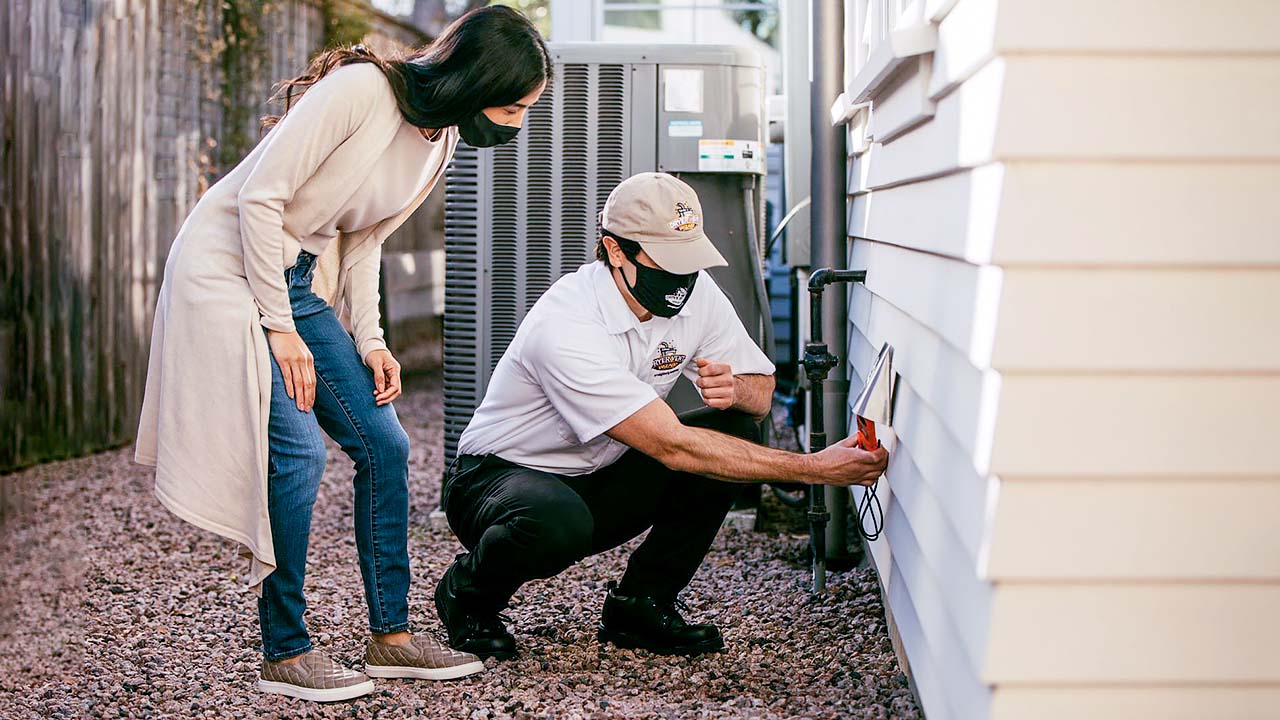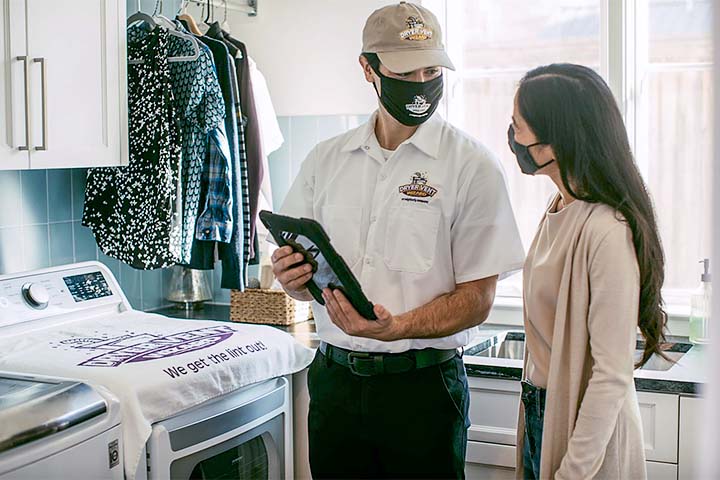Dryer Fires: An Unseen Risk

Many people overlook their dryer vent as a component of their home that needs to be maintained on a regular basis.
The primary risk is dryer fires. The National Fire Protection Agency reports that between 2014 and 2018, local fire departments responded to an average of 13,820 home fires in which dryers were involved in the ignition. Most of these fires were caused by lint build-up due to the failure to clean.1
Lint is very flammable. In fact, lint makes a great fire starter! And dryers, whether electric or gas, need a heating element or flame to function. Overheating of a heating element due to a blockage, exposure to flame or a spark from electrical wiring can ignite lint and start a preventable home fire.
There is also the issue of the performance of your dryer. Even the most expensive dryers perform only as well as their ability to vent efficiently. Clogged vent lines increase drying time, sometimes requiring additional cycles which wastes energy and money. Heat and moisture trapped in your dryer adds wear and tear to fabrics, can shorten the life of your dryer, and can lead to the build-up of mold and mildew in your laundry room. Finally, if you have a gas dryer, a clog can cause carbon monoxide to back up into your home.
We’re all familiar with the lint screen in our dryer which should be cleaned-out after each load. This shows how much how much lint is produced by single load of laundry. But even if you clean the lint screen every time, a good amount of lint (and hair, fur, and paper products) still passes through into your vent line, along with about 1-2 gallons of water vapor per load! The water vapor causes lint to adhere to and cake up on the walls of your vent line.
Dryer vent systems should be inspected, tested, and cleaned annually, or more often, based on your usage profile. Usage factors include the frequency and size of loads run in a household, pets in the household, length of the line and how it is routed.
Dryer vent issues have increased in recent years because homes and lifestyles have changed. In the past, most households had one dryer that backed up to a wall on a ground floor or basement. The vent would run straight out of the house, making it short, efficient, and easy to clean. Today many households have more than one dryer, often with one on a second floor or placed in the middle of the house for convenience. This means long vent lines with lots of twists and turns, making it harder for your system to expel all that lint, moisture, and heat. These systems are more prone to lint build-up and are harder to clean.
Having your dryer vent cleaned is not the whole story. There are several components that need to be inspected and addressed. In addition, there are cases where we cannot clean your vent line unless it is replaced, which we are prepared to do. Below we look at the key components of your dryer vent system which we inspect when we come to your home.
Your Dryer
The “lint trap,” or the cavity beneath the lint screen, often becomes clogged with lint. If your vent line has a lot of lint in it, your lint-trap likely does too and should be cleaned out. We perform this service with most vent cleanings. Also, if your dryer has not vented well over time, the main compartment inside your dryer has likely also accumulated lint. In this case, we will open your dryer and de-lint the interior to help prevent lint from igniting and spreading into your vent line.
Your Flexible “Transition” Duct
Your “transition” is the flexible duct that connects your dryer to your main vent line. This simple component can be the culprit in many poor venting situations. The most common types are semi-rigid aluminum duct, plastic or vinyl duct, or flexible-foil duct. Aluminum semi-rigid duct is a good choice but has its drawbacks. On the positive side, it is not flammable and has a smooth interior which allows lint to flow through more easily, but it also crumples when a dryer is pushed too far back against a wall, never regains its shape, and is easily kinked and punctured.
Over time, misshapen aluminum semi-rigid duct invites lint clogs, suppresses air flow, and perforations can expel lint into the area behind your dryer. Plastic or vinyl duct is an accordion style flexible duct that should not be used according to current building codes. Simply put, plastic is flammable, it attracts lint, and deteriorates over time. The accordion structure also provides more opportunity for lint to collect. This type of duct should always be replaced. Finally, flexible foil duct is often laminated with plastic, and though it may be rated as “fire resistant,” it can still burn and has the same undesirable accordion structure as plastic.
We exclusively use a great alternative flexible duct called WizardFlex™, which exceeds code requirements, is non-flammable, has a smooth interior, regains its shape when compressed, and is puncture resistant.
Your Main Vent Line
This is your primary vent line which is routed to a termination point on the outside of your home, which may be on a side wall, on the roof, or under a soffit. Sometimes the line is exposed, or viewable, in an attic, basement, or garage, and sometimes it's hidden inside walls, floors, or ceilings.
The main thing you need to know about a main dryer vent line is that it needs to be rigid metal of a specified thickness, as per IMC and IRC building codes.2 Current building codes haven’t been around forever, though, and builders or remodelers have been happy to use cheap plastic or flexible aluminum duct (as described above) which, when we see it, is usually deteriorating.
Importantly, flexible duct used as a main vent line cannot be cleaned with the proper tools, such as powered rotating brushes, since they will likely tear the flexible duct apart. So, aside from its other drawbacks, you can’t clean flexible duct. If you have flexible duct as your main vent line, we will recommend replacing it, and will not proceed with a cleaning if we cannot safely do so. We are fully prepared to replace your vent line with proper rigid aluminum pipe which we stock in our vans.
Your Vent Cover
We always inspect your vent cover on the outside of your home, which may come in any number of varieties. Whatever type it is, we make sure it’s clean and in good working order, and that it maintains a 4” opening (the same shape and size as your vent pipe). Many are old and disintegrating, which we can replace. Louvered vent covers are most common. We recommend 3-louvered covers since the types with 4 or more louvers catch more lint and break more easily. We also recommend removing any kind mesh or screen used to keeps pests out, as this creates a new place for lint to accumulate and form a barrier to air flow.
To keep the pests out, we recommend pest-resistant covers which come in different varieties, including a high-end metal version. Pest-resistant covers help prevent birds and other pests from nesting in your vent line, which is very common, allow for strong air flow, and do the best job of preventing backdraft air from flowing from the outside into your home.
Booster Fans
Booster fans are required when the effective length of your vent line reaches 35’, but requirements can vary based on your dryer manufacturer’s specifications. A booster fan is installed on your vent line and is triggered when air flow from the dryer begins, boosting air flow to the outside. In the right situations, this is necessary, but booster fans require regular maintenance and cleaning, and are expensive. We stock and install booster fans, but we may also recommend rerouting your line, if possible, to shorten it and eliminate the need for a booster fan.
Warning Signs
If you haven’t had your vent line inspected in recent memory, you should do so. You vent line should be cleaned annually, or more frequently. But if you experience any of the warning signs below, you should not wait to schedule a professional inspection:
- Long drying times
- Lint build-up behind your dryer or in the door seal
- Overheat shut-off (some models provide an indicator warning light)
- No lint on your lint screen
- Unusually hot dryer and clothes
- Moldy smell
Our Approach
Dryer Vent Wizard is a full-service dryer vent company. We not only clean, but repair, reroute and install new dryer vent systems.
When we come to your home, we inspect every component of your dryer vent system to make sure it complies with building codes, is in good repair, and provides the safest and most efficient means to vent all that heat, moisture, and lint to the outside your home. Inspections include internal and external air flow tests. We then speak with you, explain our findings, and provide an itemized proposal before we do any work.
We clean your entire vent line using flexible rods with powered rotating brushes that scrub, loosen and remove built-up lint. We clean from inside or outside the home, based on the circumstances. We may also use compressed air with a special nozzle which blasts and pulls out caked-up lint. This method is used mostly with larger, multi-unit jobs. Compressed air should not be confused with “blowing” out your vent with a vacuum or blower, which is a cheap, fast and highly ineffective way to clean a dryer vent! No reputable vendor will use this method.
Our vans are stocked with all the best materials and tools so we can tackle most every job in one appointment, from inspection to completion.
We are fully insured, our techs are all background checked, and we provide our 90-day “Done Right Promise” which promises that we will return to your home to correct any ongoing issues for 90-days. It is our mission help prevent home fires, improve dryer efficiency, and to provide prompt, professional service and great experience for every homeowner.
To schedule your inspection, please call us at: (203) 803-2068.
Jim Selden, Owner
Dryer Vent Wizard of Norwalk
Serving Fairfield County

1. National Fire Protection Agency Research – Home Dryer Fires, June 2020
2. IMC – International Mechanical Code, 2018; IRC – International Residential Code for One- and Two-Family Dwellings, 2018.
